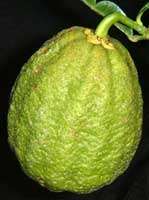Citrus cavaleriei
Citrus cavaleriei or Citrus ichangensis, the Ichang papeda (Chinese: 宜昌橙), is a slow-growing species of papeda that has characteristic lemon-scented foliage and flowers.
| Citrus cavaleriei | |
|---|---|
 | |
| Scientific classification | |
| Kingdom: | Plantae |
| Clade: | Tracheophytes |
| Clade: | Angiosperms |
| Clade: | Eudicots |
| Clade: | Rosids |
| Order: | Sapindales |
| Family: | Rutaceae |
| Genus: | Citrus |
| Species: | C. cavaleriei |
| Binomial name | |
| Citrus cavaleriei | |
| Synonyms | |
| |
It is native to southwestern and west-central China[1] and is likely named for the city of Yichang (宜昌), in China's Hubei province. It is sometimes referred to as Citrus × ichangensis.
The Ichang papeda's main claim to fame is its unusual hardiness. With the exception of Poncirus trifoliata, it is the hardiest citrus plant, tolerating both moderate frost and damp conditions.[2]
Description
Relatively rare in cultivation, the Ichang papeda is a large shrub or small tree, growing to 3–4.5 m,[3] and produces a small, mandarin-like fruit. Leaves feature a broad petiole, and resemble the leaves of the yuzu and the kaffir lime in appearance. The fruit has a fragrant, but rugged rind, and may be oval, spherical, or flattened in shape, ripening to yellow or orange. The fruit contains many large monoembryonic seeds and a small quantity of bitter or sour juice; some fruits lack juice entirely and are instead filled with a mass of pith and seeds.
The Ichang papeda is occasionally grown as an ornamental.
Hybrids
- Ichang lemon (also known as the shangjuan)[2]
- Yuzu[2]
- Kabosu
- Hyuganatsu
Both the shangjuan and the yuzu have a number of culinary uses and are notably cold-hardy.
References
- Khan, Iqrar Ahmad (2007). Citrus genetics, breeding and biotechnology. CAB International. p. 27. ISBN 978-0-85199-019-4.
- Spiegel-Roy, Pinchas; Goldschmidt, Eliezer E. (1996). Biology of citrus. Cambridge University Press. p. 32. ISBN 978-0-521-33321-4.
- Hogan, Sean (2008). Trees for all seasons: broadleaved evergreens for temperate climates. Timber Press. p. 79. ISBN 978-0-88192-674-3.